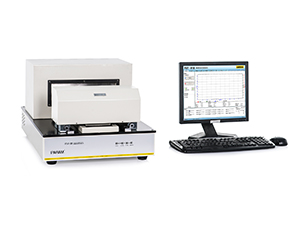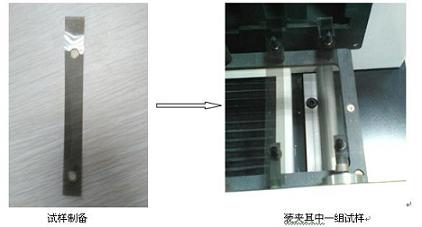Abstract: Most of the labels used outside beverage bottles are PET , PVC , PP heat shrinkable films, which are packaged using the principle of heat to shrink the sleeve labels. Whether the label can maintain a good fit during shrinkage, it is necessary to monitor whether the shrinkage, shrinkage force and other indicators are appropriate. If the shrinkage or shrinkage force of the heat-shrinkable label film is too large or too small, the label may be easily shrunk, the bottle may be deformed, and the label may not be attached. In this paper, the new type of film thermal shrinkage tester prevails, combined with the ISO 14616 standard test to study the shrinkage performance of the PVC bottle heat shrinkable label film of the beverage bottle . The test principle, parameters and test process of the device are described in detail. Shrink film shrinkage test provides technical reference. Keywords: Beverage bottles, labels, heat-shrinkable label films, heat-shrinkable films, conformability, shrinkage properties, shrinkage forces, shrinkage, shrinkage forces, shrinkage forces Test significance: A bottle of label is often attached to the outside of the beverage bottle. The label is usually a self-adhesive label or a heat-shrinkable label. The former is lap-stitched with a self-adhesive on the label, and most of the labels are wrapped around the label. Most of the material is PP . The shrink sleeve type label is a shrink-sleeve type label. The shrinkage property of the shrink film label is used to cut the sleeve into a suitable size and then put it on the container, and then heat treatment is performed using steam, infrared rays or hot air passages, so that the sleeve label adheres tightly. On the surface of the container, the main material is PET , PVC , and PS . The heat shrinkable label film is a packaging material widely used nowadays, and has the advantages of compact packaging, transparent appearance, and strong fit. When the heat-shrinking film is used as a polymer material in a certain high-temperature environment during processing, the partial molecular segment is orientated in the stretching direction, and disordered coiled molecular segments will be arranged in an orderly manner until the temperature drops rapidly. The molecular chain orientation structure and internal stress are " frozen " and the finished product of the heat shrink film is shaped at this temperature. When the heat shrinkable film is applied, when it is heated again to the temperature at which it is stretched, the " frozen " molecular segment is disoriented and returns to the disordered crimped state, that is, a thermal shrinkage phenomenon. When further cooled, the heat-shrinked film will be further compacted, producing a certain amount of shrinkage force. In the process of heat shrinking sleeves , if the shrinkage rate is too large, or the shrinkage force (including shrinkage force and shrinkage force) is too high, it will easily lead to a large label consumption, and excessive shrinkage of the label causes the printed pattern to be deformed. In severe cases, plastic bottle deformation occurs; if the shrinkage rate of the label is small and the shrinkage force is too low, the label does not fit the bottle body. Therefore, the timely monitoring of shrinkage performance of heat-shrinkable label films is of key guiding significance for ensuring the beauty of beverage bottle bodies and reducing packaging costs. Figure 1 Beverage bottle heat shrink label film (sleeve label) Detection method: At present, the heat shrinkable properties of domestic heat shrinkable film product standards are mostly determined by oven or oil bath heat shrinkage. However, these two test methods can only detect the thermal shrinkage of the heat shrink film. ISO 14616 , the testing standard for heat shrinkable films released by the International Organization for Standardization , requires the use of air heating principles (ie, air baths) for the testing of various thermal shrinkage properties of films, including thermal shrinkage force, shrinkage force, shrinkage rate, and shrinkage time. And other properties. Therefore, this test will refer to the ISO 14616-1997 " Test of shrinkage performance of plastic polyethylene ethylene copolymers and their mixtures heat shrinkable film " for the heat shrinkable label film thermal shrinkage force, shrinkage force and shrinkage test. This solution will use the FST-02 thin - film heat shrinkability tester independently developed by Labthink and combined with the above-mentioned standards to test the shrinkage performance of beverage bottle PVC heat-shrinkable label film samples. 1 , test equipment FST-02 thin - film heat shrinkability tester ( Labthink ), high-precision force sensor and displacement sensor can accurately measure the heat shrink performance parameters of the sample, and the test sample can have a shrinkage strength range of 0.2 ~ 30 N , and can be Special requirements to customize a wider range of force values; contraction force measurement accuracy of ± 0.2% ; test specimen thermal shrinkage displacement range of 0.125 ~ 70 mm , thermal shrinkage displacement measurement accuracy of ± 0.125 mm ; experimental heating chamber work Temperature range from room temperature to 210 °C , temperature control accuracy of ± 0.5 °C ; equipment can test 1 to 3 groups of samples, the sample size is 130 mm × 15 mm . The equipment meets a number of national and international standards: ISO 14616 , DIN 53369 , and can accurately determine the thermal shrinking, shrinkage, and shrinkage properties of plastic films during thermal shrinkage. Figure 2 FST-02 Thin Film Thermal Tester 2. Preparation of sample Twenty specimens each having a width of 15 mm are cut along the longitudinal and horizontal directions of the PVC label film , and each of the two specimens is a group of 10 specimens in horizontal and vertical directions . Each group of specimens is used for heat. Shrinkage force, shrinkage force, shrinkage test. The length of the specimen shall ensure that there is an effective length of 100 mm between the grips . Test specimen thickness, at least 3 points, averaged. With a special sampler, two round holes are drilled on the surface of the sample to facilitate the clamping of the sample. 3. Test conditions Test Location: Jinan Languang Packaging Safety Inspection Center Test Environment: 23 °C , 50% RH Test Index: Maximum Heat Shrink Force, Maximum Cold Shrink Force, Shrinkage 4. Test procedure 4.1 Test principle The heat-shrinkable label films are respectively placed on a clamp with a displacement sensor and a force sensor, rapidly heated up to the shrinkage temperature, and then cooled, and each shrinkage performance curve that changes with time after the sample is heated in the enclosed heating chamber is tested, thereby automatically Obtained thermal shrinkage force, shrinkage force, shrinkage and set temperature and other results. 4.2 Test procedure FST-02 film heat shrinkability tester can accurately measure the various shrinkage and corresponding shrinkage of the heat shrinkable film, and the equipment is easy to operate: Figure 3 sample preparation and loading process 4.3 test results The maximum horizontal shrinkage force, maximum shrinkage force, and shrinkage ratio of the PVC bottle label at the optimum setting temperature are 3.06 N/15mm , 3.28 N/15mm , and 38.1% , respectively , and the maximum shrinkage force in the longitudinal direction. The average values ​​of the maximum shrinkage force and the shrinkage ratio were 0.101 N/15mm , 0.674 N/15mm , and 1.95% , respectively . From the above data, it can be seen that the PVC label film is a transverse shrink film, that is, the label is contracted laterally around the bottle body. to sum up: When using the FST-02 film thermal shrinkage tester to test the heat shrinkable label film, the thermal shrinking force, shrinkage force and shrinkage rate of the label film can be tested at the same time. This is currently unmatched by conventional oven method and oil bath method. of. The accuracy, intelligence, and test efficiency of the device are high. In addition to heat-shrinkable label film, it can be widely used in casing films, cluster packaging films, sterilization tableware packaging films, sports goods, craft gifts, hardware and other The shrinkage test of the product's heat shrinkable film. Labthink has been committed to providing professional testing services and equipment for customers around the world, providing customers with a large number of reference materials for the performance of packaging materials. At the same time, Labthink provides various testing instruments and solutions for barrier properties, mechanical strength and other properties. You can visit the website of Jinan Languang Company to view specific information or call us directly . Labthink expects to enhance technical exchanges and cooperation with users in various industries. 

